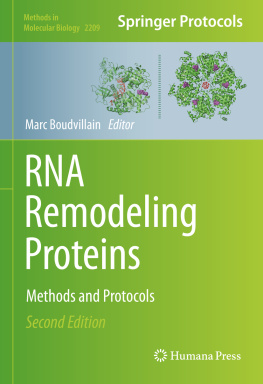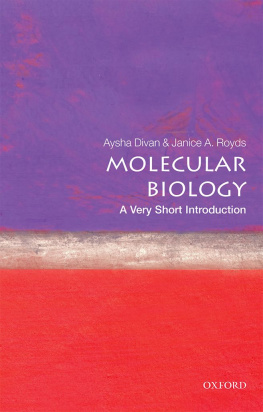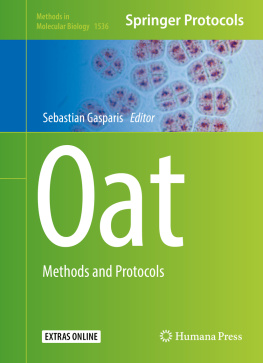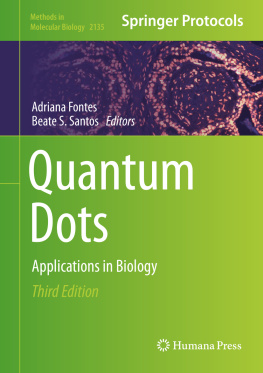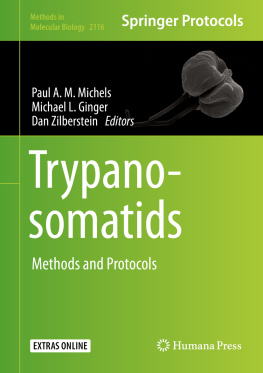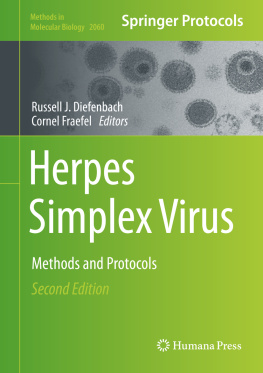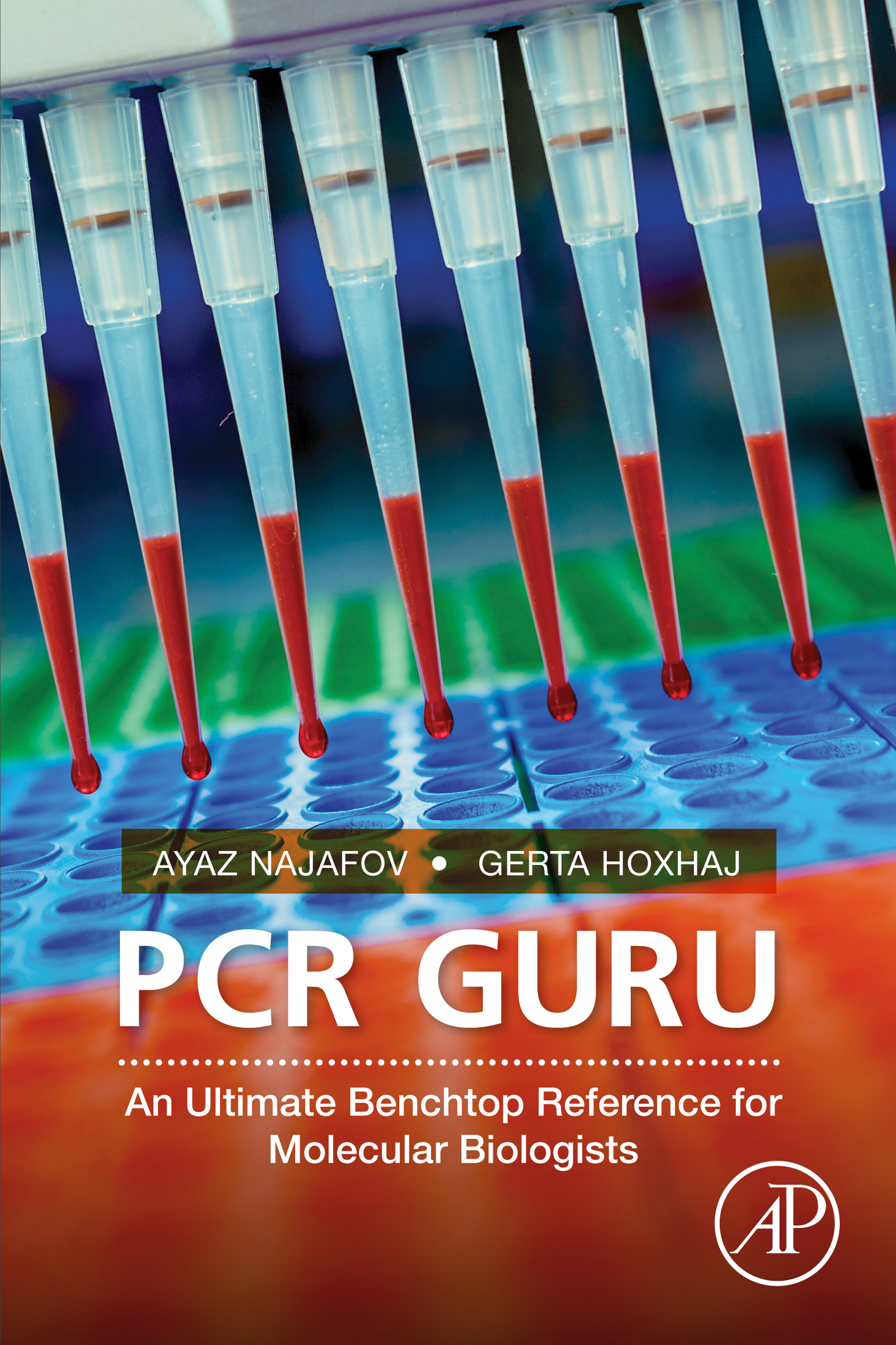Table of Contents
List of tables
- Tables in Chapter 2
- Tables in Chapter 4
List of figures
- Figures in Chapter 1
- Figures in Chapter 2
- Figures in Chapter 4
- Figures in Chapter 5
Landmarks
PCR Guru
An Ultimate Benchtop Reference for Molecular Biologists
Ayaz Najafov
Harvard Medical School, Department of Cell Biology, Boston, MA, United States
Gerta Hoxhaj
Harvard T.H. Chan School of Public Health, Department of Genetics and Complex Diseases, Boston, MA, United States
Table of Contents
Copyright
Academic Press is an imprint of Elsevier
125 London Wall, London EC2Y 5AS, United Kingdom
525 B Street, Suite 1800, San Diego, CA 92101-4495, United States
50 Hampshire Street, 5th Floor, Cambridge, MA 02139, United States
The Boulevard, Langford Lane, Kidlington, Oxford OX5 1GB, United Kingdom
Copyright 2017 Elsevier Inc. All rights reserved.
No part of this publication may be reproduced or transmitted in any form or by any means, electronic or mechanical, including photocopying, recording, or any information storage and retrieval system, without permission in writing from the publisher. Details on how to seek permission, further information about the Publishers permissions policies and our arrangements with organizations such as the Copyright Clearance Center and the Copyright Licensing Agency, can be found at our website: www.elsevier.com/permissions.
This book and the individual contributions contained in it are protected under copyright by the Publisher (other than as may be noted herein).
Notices
Knowledge and best practice in this field are constantly changing. As new research and experience broaden our understanding, changes in research methods, professional practices, or medical treatment may become necessary.
Practitioners and researchers must always rely on their own experience and knowledge in evaluating and using any information, methods, compounds, or experiments described herein. In using such information or methods they should be mindful of their own safety and the safety of others, including parties for whom they have a professional responsibility.
To the fullest extent of the law, neither the Publisher nor the authors, contributors, or editors, assume any liability for any injury and/or damage to persons or property as a matter of products liability, negligence or otherwise, or from any use or operation of any methods, products, instructions, or ideas contained in the material herein.
Library of Congress Cataloging-in-Publication Data
A catalog record for this book is available from the Library of Congress
British Library Cataloguing-in-Publication Data
A catalogue record for this book is available from the British Library
ISBN: 978-0-12-804231-1
For information on all Academic Press publications visit our website at https://www.elsevier.com/

Publisher: Sara Tenney
Acquisitions Editor: Sara Tenney
Editorial Project Manager: Fenton Coulthurst
Production Project Manager: Chris Wortley
Designer: Christian Bilbow
Typeset by Thomson Digital
Dedications
I dedicate this book to my father, Azad Najafov, who introduced me to the world of molecular biology and to my friend and mentor, brahim Bar, who taught me how to do my first PCR.
Ayaz Najafov
I dedicate this book to my family to whom I am eternally grateful for their constant support and care for me and my academic career.
Gerta Hoxhaj
Biography
Ayaz Najafov
Ayaz was born in Baku, Azerbaijan and as a high school student, participated in local and international biology Olympiads, where he had won several gold, silver, and bronze medals. He obtained his BSc and MSc degrees in Molecular Biology and Genetics from Bosphorus University, Istanbul, Turkey, and got a 2-year training in Biochemistry as an intern at Baylor College of Medicine, Houston, TX, United States. Ayaz pursued his PhD in Biochemistry at MRC Protein Phosphorylation Unit at Dundee University, Scotland, United Kingdom in Prof. Dario Alessis lab. Ayaz is currently a postdoctoral fellow in Prof. Junying Yuans lab at Harvard Medical School, Cell Biology Department.
Gerta Hoxhaj
Gerta was born in Fier, Albania. She obtained her BSc degree in Molecular Biology and Genetics, as well as a second major in Chemistry from Bosphorus University, Istanbul, Turkey. Gerta pursued her PhD in Biochemistry at MRC Protein Phosphorylation Unit at Dundee University, Scotland, United Kingdom in Prof. Carol MacKintoshs lab. Gerta is currently a postdoctoral fellow in Prof. Brendan Manningss lab at Harvard T.H. Chan School of Public Health, Department of Genetics and Complex Diseases.
Preface
This book was written with an aim of providing researchers practicing molecular biology, whether at their beginner or expert stage, with a handy tool and reference for setting up, performing, optimizing, and troubleshooting polymerase chain reaction (PCR). We believe that this book will provide tremendous assistance for solving problems associated with challenging cases of PCR.
This book does not provide the reader with vast details of the PCR theory and the multiple applications of the technique. As this book is a laboratory guide, the emphasis here was made on the technical aspects of employing PCR as a tool in molecular biology laboratories and the issues were described in bench terms, which makes the book more comprehendible to the end users of the technique.
General optimization and troubleshooting strategies, as well as a detailed guide for addressing specific PCR problems, tips and tricks developed and learned through years of experience with PCR and its various applications, several special cases for PCR, and appendices with protocols and other useful information related to PCR, make this book a practical reference all molecular biology laboratories can benefit from.
Acknowledgments
We would like to thank Ali Kavak, Aydin Mammadov, and Cafer Ozdemir for their comments and suggestions during the preparation of this book.
Note to the Reader
All agarose gel images published in this book were inverted (negative) to save ink/toner used to publish this book.
As DNA polymerase is the only enzyme in the standard PCR setup, and as there are many other DNA polymerases (besides Taq) used in modern molecular biology labs, we will refer to DNA polymerase as the enzyme.
We will use the term target for the specific sequence that is intended to be amplified using a set of primers.
Chapter 1
Introduction
Abstract
Origins of polymerase chain reaction (PCR) and its history are briefly introduced in this chapter. The components of the PCR are introduced and the effect of the component concentrations on the fidelity, specificity, and efficiency of PCR are explained. Various thermostable DNA polymerases that are currently being used in the PCR setups around the world are listed. The power of the cyclic and the exponential nature of PCR, the effect of the reaction reaching the plateau, and how this affects the specificity and yield of the reaction are discussed. Finally the rise in the popularity of this method since it was first introduced by Dr. Kary Mullis in 1983 is illustrated.


